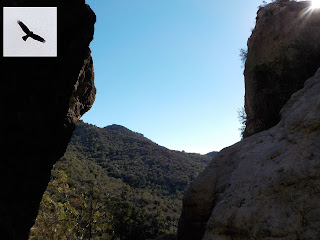We seem to have taken quite a detour last week to
get down to this level and the waterfall should be over there somewhere. We’ll
follow our ears and get there somehow but first, that looks interesting.
There’s probably a correct technical term for these shallow erosions but I just
call them cavelets. Let’s climb up and take a look. As you can see from the
staining of the rock face, water is leaching minerals from the rocks and if you
look up there you can see small stalactites forming. There are also white
deposits blooming on the walls which my geologist friends tell me is probably
gypsum/selenite. They contain calcium
and sulphur so, along with the limestone rocks which contain calcium and carbon,
and the water, we have carbon, oxygen, and hydrogen (the basic elements of
life) plus at least a couple of others to add to the recipe. We’ll push our way
up through these bushes using this tumbling water course as our stairs and see
what’s going on.
And up here, below the dripping stalactite, if you
look carefully you can just see some threads of green algae forming. There’s a
whole world of wonder in this little splash pool which began when large
molecules of dissolved organic substances from the stalactite attached
themselves to the wet rock. These neutralised the electrical charge of the
water surface and allowed bacteria to colonise and they, in turn, secreted
sticky strands that formed a nutrient trapping matrix. This matrix, known as the
biofilm to periphytologists (people who study slimy rocks – yes, there really
are such people), then served as a base for more bacteria to expand and
diversify the biofilm and then for our green algae to grow. The algae, in its
turn, will provide a home for microscopic life forms such as the ciliate we
found in Life In The Olive Grove .
Algae are very basic life forms but we also have
some higher forms of plant life up here. These fig branches, tenaciously
clinging to the underside of this crack are just coming into bud and down in
the damp crevices we have some lip ferns whilst out on the dry, stony ground,
the beautiful but dangerous mandrakes are coming into flower. Their relative
simplicity or complexity is reflected in their evolution: the flowering plants
which include the fig and mandrake have been with us for about 120 million years,
the ferns about 320 million years and the green algae maybe as long as 500
million years. Us? Well, as primates about 55 million years but as Homo sapiens only a couple of hundred
thousand years.
Have you noticed these cottony threads in amongst
the berries of this lentisc bush here? Alongside the evolution of plants came
the evolution of insects and these threads look like the work of woolly aphids.
Pass me the field microscope and I’ll see if I can find one for you. There’s
one look, if you study him closely you can see him sucking up the sap from the
plant. And where there are insects there are predators; there’s a minute spider
that has his eye on stuffed aphid for lunch. Talking of which, let’s see if we
can find some cave spiders lurking in the deeper recesses.
Do you think that you can wedge yourself up into
that crack and see if there’s anyone about? Plenty of webs? That’s a good sign.
You’ve found one? Good, I’ll squeeze in beside you and take a look. Hmm. It’s
not a cave spider but he is rather interesting. Do you remember me telling you
that you don’t have to worry about spiders in Crete because we only have one venomous
one and you’re unlikely to come across it? Guess what? You’ve found one. Sorry,
probably not the best time to impart that information when you’re perched
precariously thirty metres up a cliff face, but don’t worry they’re pretty shy
creatures and he won’t bother you unless you threaten him. All the same I think
we’ll climb down. That was a Mediterranean Recluse Spider and although his bite
can cause nasty skin lesions, a condition known as loxoscelism for which
there’s no known treatment, it is rarely fatal. Having said that, there was a
fatality last year in Italy but I believe that the unfortunate victim was
already suffering from some sort of immune deficiency, which would have been a
contributing factor.
Still, venomous spiders aside, a pleasant little
diversion and a different angle from which to look at this wonderful thing
called life. Now how are we going to get down from here?
The Extra Bit
Last week
I glibly said that there is “only one authentic palm lined beach on the whole
continent [of Europe]” and that was at Vai on the east coast of Crete. I am
indebted to Jackie Strasis for reminding me that Phoenix theophrasti also lines Preveli Beach in southern Crete and
I have also learnt that there are yet more at Ayios Nikitas in Heraklion
Prefecture. Further research has turned up one other native European palm, The
Mediterranean Dwarf palm, Chamaerops
humilis, which lives in south west Europe. Just goes to show – you can’t
believe a word that I say. Thanks for correcting me Jackie.
*********************************************************************************
LINKS:
Naturalists
(the facebook page that accompanies this blog)
See detailed pictures at
http://www.inaturalist.org/login (search - people-stevedaniels-observations)














